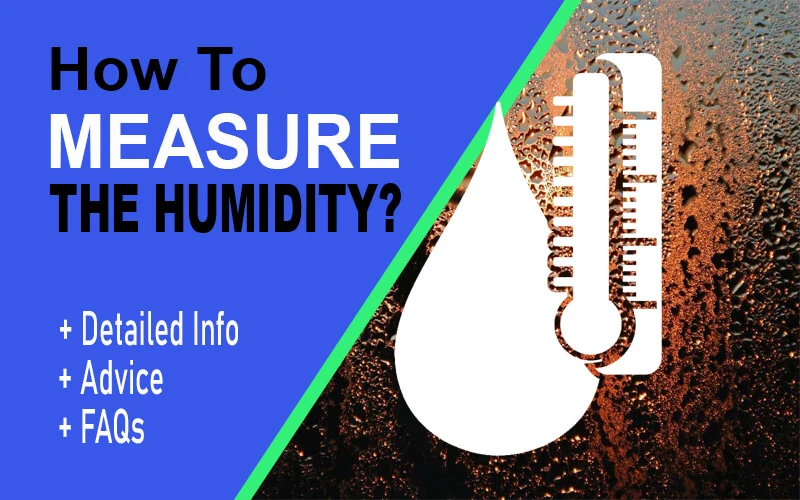How to Measure Humidity? [+Right Way +Advice + FAQs] 2023
Do you know, How to measure humidity? Several methods exist for measuring humidity, but the most common is using a hygrometer. By measuring the aggregate of water vapor in the air, hygrometers can determine the relative steaminess. Using the quantity of water vapor in the air as a metric to determine its relative steaminess.
What is Humidity?
Water vapor determines the humidity of the air. In the case of air, it is all the time expressed as a percentage of the maximum quantity of water vapor that can be held at a specific temperature. When the air is steamier, there is more water vapor present.
As well as evaporating from bodies of water, plants can also produce water vapor through transpiration. Water vapor can also be breathed in by humans. Temperature determines air’s ability to hold water vapor.
It is easier for air that is warm to keep more water than air that is cold. Humidity plays a significant role in the weather and climate of an area. It can affect temperature, precipitation, and other aspects of the environment.
You Might Also Like This!
How to Measure Humidity?
A hygrometer is the most common instrument used to measure humidity. All hygrometers follow the same principle, regardless of their form. By measuring water vapor in the air, the hygrometer calculates moisture. A measurement of steaminess is based on air vapor content.
Generally, wet-bulb hygrometers are used in environments with low relative humidity. Hygrometers with wet bulbs are made up of thermometers with a wick wrapped around the bulb. The wick is kept damp with distilled water. During the wick’s immersion in water, the thermometer’s moisture condenses onto it.
What are the 2 Most Common Ways to Measure Humidity?
There are a few different ways to measure humidity, each with its advantages and disadvantages.
- The most common way to measure humidity is with a hygrometer, which can be either a standalone instrument or built into another device such as a weather station. A hygrometer can be analog or digital in design, depending on whether it measures the amount of water vapor in the air.
- In addition to measuring humidity, a psychrometer can be used. Among the two thermometers, one has a water-absorbing bulb. The psychrometer is placed in the air, and the two thermometers are allowed to come to an equilibrium.
How do You Check Humidity Without a Hygrometer?
Using ice cubes in place of a hygrometer, place four or five in a glass of water. The steaminess can then be assessed. Make sure that the glass of water is on a table inside the room where you are going to check the steaminess level.
The glass of water will cause the air around it to cool, and as the air cools, it will become saturated with water vapor. Water vapor in the air is determined by its temperature, so you can indirectly measure the humidity by measuring the temperature around a glass of water.
Can We Measure Humidity by Thermometer?
Yes, but there are some caveats to consider. A digital thermometer can measure temperature and relative humidity, but it is essential to understand how these two measures are calculated and what they represent.
An analysis of a sample of material’s temperature is an analysis of its average kinetic energy. Molecular motion is accelerated by increasing temperature. In relative steaminess, we can find out how many water vapor is present in the air relative to its volume. Water vapor can be held in more air at a warmer temperature.
FAQs: Measure Relative Humidity?
What happens if the humidity is too high?
In high humidity, windows can get Fogg, walls can moldy, clammy air can clog, and there can be a musty smell. High steaminess prevents the air from keeping as much water vapor as it can. A whole host of other problems can also occur as a result. Too much humidity can also lead to static electricity, which can be a nuisance.
Do fans reduce humidity?
There are a few different ways to reduce humidity in a space, and one of them is by using fans. Circulating air in a room helps evaporate moisture, which can accumulate in a room. Smaller spaces can benefit from this method of reducing humidity. The air will not be completely free of moisture though, since fans do not completely remove all of it. In larger spaces or spaces with high humidity, other methods may be necessary to remove the moisture altogether.
What is normal humidity?
In order to maintain good fitness and comfort, relative steaminess should be between 30% and 50%. This range of humidity levels allows the body to sweat and release heat while preventing the air from feeling too dry or too moist. At lower humidity levels, the air can feel dry and irritate the respiratory system, while at higher levels, the air can feel moist and encourage the growth of mold and mildew.
Is humidity good for skin?
H2O is thought to be beneficial for the skin by a variety of schools of thought. On the one hand, high humidity can help keep skin hydrated and protect against chapped and dry skin.
Conversely, too much humidity can cause skin problems such as acne and excessive sweating. To find the right balance for your skin type and your lifestyle, you must first determine what works for you. For example, if you live in a dry climate, you may need to use a humidifier to help keep your skin healthy.
Conclusion
While the calculator is an excellent tool for finding out the humidity in your area, it’s essential to know that there is more than one way to measure the humidity. Each way of measuring steaminess has its own benefits and drawbacks.
No matter which method you choose, though, you’ll be able to get a pretty good idea of the humidity in your area. Still if you are confused and want know more about, how to measure humidity? then comment below, we usually response in few hours!



![Benefits of a Humidifier while Sleeping, Sick or Cold [2023]](https://prohouseideas.com/wp-content/uploads/2023/01/benefits-of-a-humidifier-768x480.webp)
![Evaporative vs Ultrasonic Humidifiers [ Types | Vs | Cost] 2023](https://prohouseideas.com/wp-content/uploads/2023/01/evaporative-vs-ultrasonic-humidifiers-768x480.webp)
![Water Softener vs Descaler [+Differences] +Guide 2023](https://prohouseideas.com/wp-content/uploads/2022/08/water-softener-vs-descaler-768x480.webp)

![How to Choose a Water Softener? [+Guide +Tips] 2023](https://prohouseideas.com/wp-content/uploads/2022/08/how-to-choose-a-water-softener-768x480.webp)